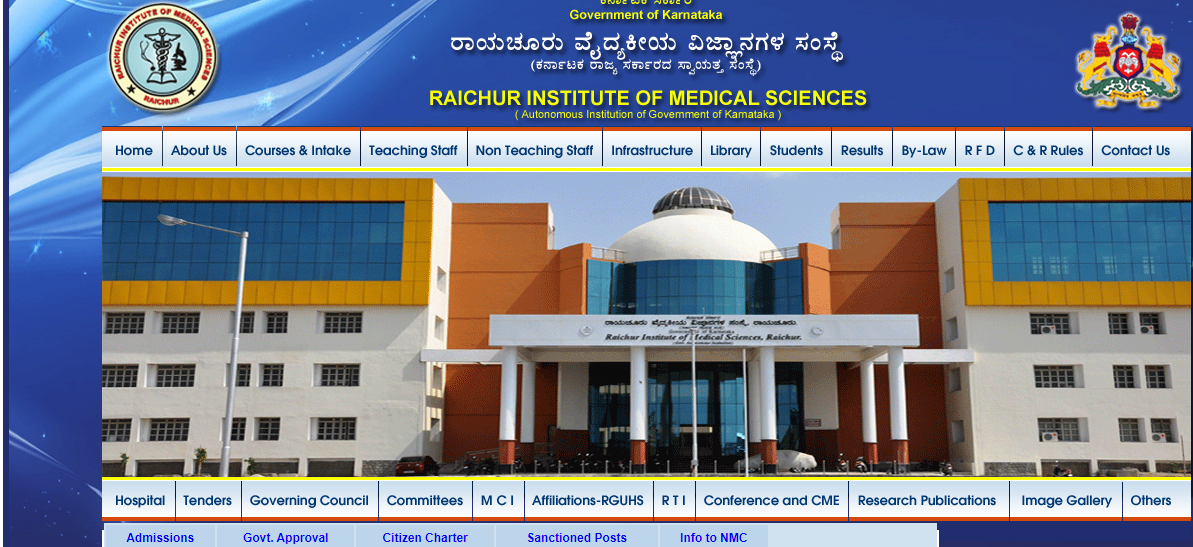
Raichur Institute of Medical Sciences,Raichur
About Us
VISION
Raichur Institute of Medical Sciences, Raichur will seek to be a center of excellence in Medical Education, Research, and HealthCare services at the national and international level.
MISSION STATEMENT
The institute in pursuit of its vision will provide outstanding educational experience, in all the disciplines of Medicine and allied Health Sciences, in a supportive environment of scholarship, research, integrity, critical thinking and self directed learning. It will provide comprehensive, culturally sensitive, community oriented Health care to individuals and families.
VALUES
The vision and mission of the institute will be accomplished using the values of congeniality, openness, inclusiveness and community involvement at a local and global level.
Area
The district is bounded on the North by the district of Gulberga, on the West by the districts of Bijapur and Dharwar, on the East by the district of Mababoobnagar of Andhra Pradesh, and on the South are the districts of Kurnool also of Andhra Pradesh, and Bellary. The two rivers, the Krishna and the Tungabhadra from the entire North and Southern boundaries of the district.
The geographical area of the district, according to the Central statistical organization of the Government of India, is 14,013 Sq Kilometers which works out to 5410 sq. miles. But the reporting area of the district for land utilization purposes, as worked out by the Commissioner for Survey, Settlement and Land Records in Mysore, Bangalore is 14007.9 Sq.Kilometers or 5,435.5 sq.miles. This slight difference is due to the different methods employed by them in measuring the area. The population of the district according the 1961 census, was 11,00,895. In terms of area, the district occupies the third place among the districts of the State, while in respect of population it occupies the tenth place. It accounts for 7.36 percent of the total area and 4.6 percent of the total population of the State in 1961; the density of population then worked out to 202.51 per square mile or 77 per square kilometer and this was much below the State average, which was 319 per square mile or 123 per square kilometer, and the lowest next only to North Kanara district.
Population
The population of the district according the 1961 census, was 11,00,895. In terms of area, the district occupies the third place among the districts of the State, while in respect of population it occupies the tenth place. It accounts for 7.36 percent of the total area and 4.6 percent of the total population of the State in 1961; the density of population then worked out to 202.51 per square mile or 77 per square kilometer and this was much below the State average, which was 319 per square mile or 123 per square kilometer, and the lowest next only to North Kanara district.
Climate
The climate of the district is characterised by dryness for the major part of the year and a very hot summer. The low and highly variable rainfall renders the district liable to drought. The year may be divided broadly into four seasons. The hot season begins by about the middle of February and extends to the end of May The South-west monsoon is from June to end of September. October and November are the post monsoon or retreating monsoon months and the peirod from december to the middle of Febrary is the cold season.
Temperature
The only meteorological observatory in the district is at Raichur. The data of this observatory may be taken as representative of the conditions in the district. December is the coldest month with the mean daily maximum temperature at 29.3 Degree C. (84.8 F) and the mean daily minimum at 17.7C (63.9F) The nights are generally cool in the season, but day temperatures sometimes reach 35 to 38 Degree C.The period from about the middle of February to May is one of continuous rise in tenoeratyres, May is the hottest month, the mean daily maximum temperature being 39.8 (103.7 F) The heat is oppressive till the onset of the south-west mansoon by about the first week of June. Thereafter the weather becomes slightly cooler and continues to be so till the end of the South-west mansoon season. Day temperatures show a slight increae in October. From November, both day and night tmperatures gradually decrease till December.
The highest maximum temperature ever recorded at Raichur was 45.6 C (114.1F) on 23rd May 1928 and the lowest minimum was 10.0 C (50.0F) on 14th January 1899 and 13th December 1945.
M.B.B.S.

Bachelor of Medicine, Bachelor of Surgery (Latin: Medicinae Baccalaureus, Baccalaureus Chirurgiae; abbreviated in many ways, most commonly MBBS, but also MB ChB, BMBS, MB BCh, MB BChir), is the primary medical degree awarded by medical schools in countries that follow the tradition of the United Kingdom. The historical degree nomenclature states that they are two separate undergraduate degrees. In practice, however, they are usually combined as one and conferred together, and may also be awarded at graduate-level medical schools.
Bachelor of Medicine and Bachelor of Surgery (MBBS), is a professional degree in medical science. A person holding the MBBS degree becomes a certified medical practitioner. The duration of MBBS course is five years and six months including one year of rotational internship at hospitals, health centres, and health camps organised by non-profit organisations (NGOs). MBBS course syllabus includes studies on anatomy, pharmacology, pathology as well as community health & medicine, paediatrics, and surgery. The syllabus, prescribed in such a way that MBBS degree holders can choose a specialisation for further majoring and practising medicine. The career specialisations for MBBS students are Nephrology, Cardiology, Gynecology, Anesthesiology, Organ Transplant, Endocrine, and General Surgery, etc.
MD - Bio-Chemistry
MD - Forensic Medicine/Forensic Medicine & Toxicology
MD - General Medicine
MD - Microbiology
MD - Paediatrics
MD - Pathology
MD - Pharmacology
MD - Physiology
MD - Social & Preventive Medicine / Community Medicine
MD/MS - Anatomy
MS - Orthopaedics
- Log in to post comments
- 51 views
